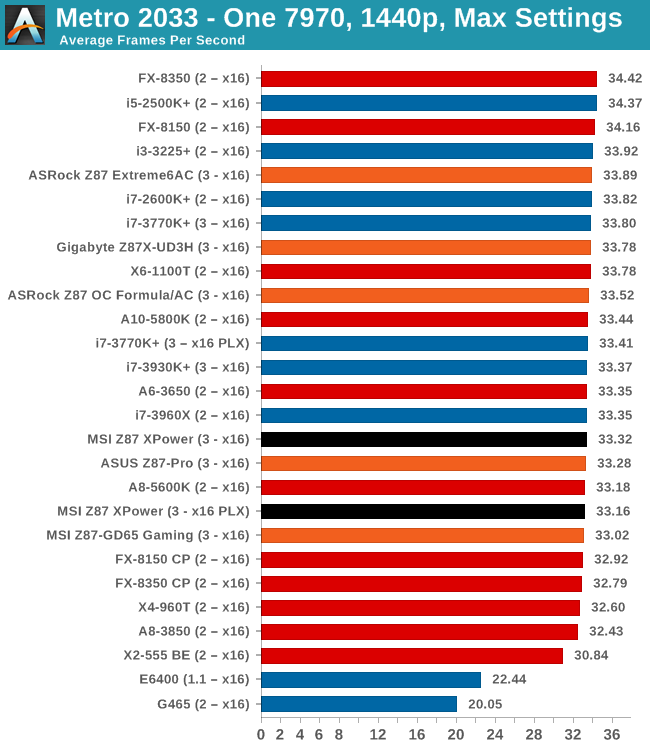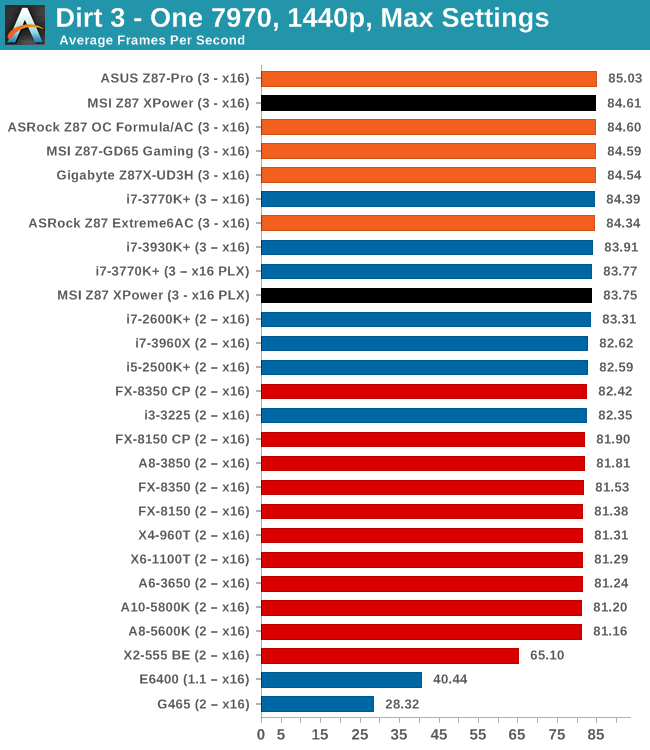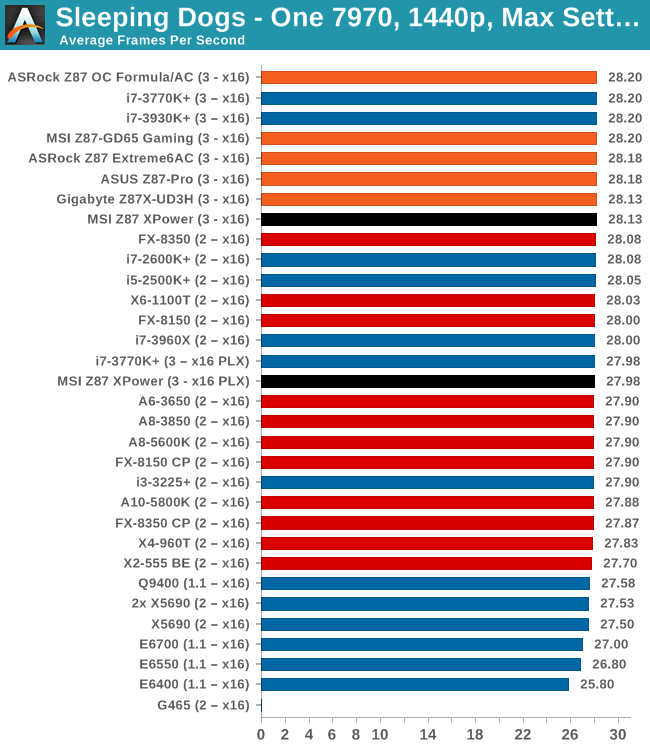MSI Z87 XPower Review: Our First Z87 with PLX8747
by Ian Cutress on August 12, 2013 9:00 AM EST- Posted in
- Motherboards
- MSI
- PLX
- Z87
Gaming Benchmarks
Metro2033
Our first analysis is with the perennial reviewers’ favorite, Metro2033. It occurs in a lot of reviews for a couple of reasons – it has a very easy to use benchmark GUI that anyone can use, and it is often very GPU limited, at least in single GPU mode. Metro2033 is a strenuous DX11 benchmark that can challenge most systems that try to run it at any high-end settings. Developed by 4A Games and released in March 2010, we use the inbuilt DirectX 11 Frontline benchmark to test the hardware at 1440p with full graphical settings. Results are given as the average frame rate from a second batch of 4 runs, as Metro has a tendency to inflate the scores for the first batch by up to 5%.

| Metro 2033 | 1 GPU | 2 GPU | 3 GPU |
| AMD | |||
| NVIDIA |
Dirt 3
Dirt 3 is a rallying video game and the third in the Dirt series of the Colin McRae Rally series, developed and published by Codemasters. Dirt 3 also falls under the list of ‘games with a handy benchmark mode’. In previous testing, Dirt 3 has always seemed to love cores, memory, GPUs, PCIe lane bandwidth, everything. The small issue with Dirt 3 is that depending on the benchmark mode tested, the benchmark launcher is not indicative of game play per se, citing numbers higher than actually observed. Despite this, the benchmark mode also includes an element of uncertainty, by actually driving a race, rather than a predetermined sequence of events such as Metro 2033. This in essence should make the benchmark more variable, but we take repeated in order to smooth this out. Using the benchmark mode, Dirt 3 is run at 1440p with Ultra graphical settings. Results are reported as the average frame rate across four runs.

| Dirt 3 | 1 GPU | 2 GPU | 3 GPU |
| AMD | |||
| NVIDIA |
Civilization V
A game that has plagued my testing over the past twelve months is Civilization V. Being on the older 12.3 Catalyst drivers were somewhat of a nightmare, giving no scaling, and as a result I dropped it from my test suite after only a couple of reviews. With the later drivers used for this review, the situation has improved but only slightly, as you will see below. Civilization V seems to run into a scaling bottleneck very early on, and any additional GPU allocation only causes worse performance.
Our Civilization V testing uses Ryan’s GPU benchmark test all wrapped up in a neat batch file. We report the average frame rate of a 5 minute test.

| Civilization V | 1 GPU | 2 GPU | 3 GPU |
| AMD | |||
| NVIDIA |
Sleeping Dogs
While not necessarily a game on everybody’s lips, Sleeping Dogs is a strenuous game with a pretty hardcore benchmark that scales well with additional GPU power due to its SSAA implementation. The team over at Adrenaline.com.br is supreme for making an easy to use benchmark GUI, allowing a numpty like me to charge ahead with a set of four 1440p runs with maximum graphical settings.

| Sleeping Dogs | 1 GPU | 2 GPU | 3 GPU |
| AMD | |||
| NVIDIA |
GPU Conclusions
The salient point in our testing is the fact that the MSI Z87 XPower is the first PLX motherboard we have tested on Z87. This means that anything dual GPU and up is going to be affected, especially in our three-way tests when the XPower is running at X16/x8/x8 via the PLX.
The results are similar to what we saw with Z77:
- In single GPU mode, if the GPU is put into a PLX managed slot, we lose <0.5% performance
- In dual GPU mode, there is essentially no difference to PLX/non-PLX
- In tri GPU mode, we see gains using the PLX – from 2-10% over non-PLX motherboards










35 Comments
View All Comments
DanNeely - Monday, August 12, 2013 - link
You will. Most commonly they're 10 expansion slots high (the size of the first generation of extra large/tall mobos). Newegg carries 11 ten, 7 eleven, and 1 twelve slot tall cases vs 333 seven and 74 eight slot tall models.peterwhitehouse - Monday, August 12, 2013 - link
I think the form factor description is totally wrong surely it should be XL-ATX and not E-ATX?DanNeely - Monday, August 12, 2013 - link
That or HP-ATX; the other taller than normal board bucket. EATX is still 7 slots tall but somewhat wider to give room for two CPU sockets and ram banks in the top area.Nfarce - Monday, August 12, 2013 - link
Every time I see a Haswell tested and overclocked I cringe looking at the thermals. Even with an H70 this thing hits 85C at 4.7GHz. My 2500K stays at 4.8 on 1.39V at 60C in summer ambients on an ND-D14. Would like to upgrade to an i7 for video editing as well as a gaming, all-in-one system, but can't see that kind of heat happening. Maybe Ivy is the way to go for the last of the great overclocking chipsets?Death666Angel - Monday, August 12, 2013 - link
Have you listened to the Podcast #22 with Dustin Slavos? Anand and him discuss Haswell OCing very in depth, you should check it out.As it stands now, yes, you are thermally limited with Haswell. You currently get a little less OC headroom than with Ivy Bridge, but the IPC increase means you are still ~5% ahead in average work loads. When yields mature, you might see OC parity or even an increase, in which case Haswell will be about 10%+ better, sometimes more if the program takes advantage of the new features with Haswell. If you are to upgrade to a completely new system, get Haswell or Ivy-Bridge-E which should do better in the OCing department since it will likely use solder to connect the die and the IHS. I personally don't see the appeal to do an upgrade from one generation to the next these days, unless money isn't an issue.
But, 85°C is not an issue for the CPU. If the system isn't louder because of Haswell, anything under 90°C should be okay. And unless the two system were identical, you can't compare your 60°C to the 85°C, the cooler are different, you have different fans, different care fans and different positioning, difference socket placement..... :)
Nfarce - Monday, August 12, 2013 - link
"But, 85°C is not an issue for the CPU. If the system isn't louder because of Haswell, anything under 90°C should be okay. And unless the two system were identical, you can't compare your 60°C to the 85°C, the cooler are different, you have different fans, different care fans and different positioning, difference socket placement..... :)"I understand all of that of course. However, my summer temps - I live in the south of the US where it's hot nearly half the year - and my air conditioner bill would not like something cranking out 180F+ degrees. It's already hot enough in the room blowing 140F out the back with the Sandy rig combined with the 140F coming from GPUs. Bottom line - Haswell, while faster clock for clock than the Ivy which itself is faster clock for clock than Sandy, is not the "next level" I was hoping for. Finally, as stated, the only reason I'm looking to upgrade to i7 from i5 is to speed up my video editing and rendering time, which I'm doing more and more of these days.
basroil - Tuesday, August 13, 2013 - link
Nfarce, it doesn't matter if you put 90W of heat into your apartment at 180F or at just 90F, your room temperature increases the same amount! In fact, those massive coolers actually draw so much more power that you'll actually increase temperatures. Don't spout nonsense like that, it's beyond ridiculous. If you care for cooler temperatures, go for the system that uses the fewest Watt average (including idle time), and that system will surely not include this mobo!ggathagan - Monday, August 12, 2013 - link
"$440 is a big ask from MSI, which is placated some by the inclusion of a mouse mat and goodies in the box.""Two thumbs up from MSI on the self-branded additions to the box."
Seriously Ian?!
$440 should buy me an amazingly solid board that will do what its manufacturer claims it will.
Anything less is unacceptable and simply encourages board makers to continue this trend of cranking out their top tier products before they are actually ready for everyday use.
Spare me the marketing material, the out-dated 2.4GhZ wireless the useless 'Killer' NIC and spend your time/money on producing a satisfactory motherboard!
C.C. - Monday, August 12, 2013 - link
Dumb ass spammer..If she only makes $62 an hr, yet brought in $20,900 in a month..that "few hours" she worked totals 337 hours..If you are going to waste your time typing spam messages that everyone here is smart enough not to follow, then you *SHOULD* be smart enough to use a friggin' calculator Bahahah...On topic, ggathagan you are exactly right! $3 worth of useless marketing fluff doesn't really make you want run out and buy this board over others that are half price but perform just as well..For $440, this thing should come with a full set of custom waterblocks for the VRMs/chipset, and ship with a stable BIOS for God's sake! I really liked the platform offerings of Z87 on paper, but I am glad I held onto my 3770k @ 4.8Ghz..
Every Z87 board seems to have their own slew of issues, from BIOS issues to XMP issues etc etc..My $115 ASRock Z77 Extreme4 has been rock solid from June 1st of 2012..It runs 24/7 @ 100% load (F@H), and is the BEST MB I have ever owned under $150..
I used to buy nothing but higher end boards ($200-250), and am super glad I took a chance on this "mainstream" performance board! I sure hope Ivy-E brings some updated X79 boards (native USB 3, more SATA 6 ports, better Audio) so I have something to be excited about!
b3nzint - Tuesday, August 13, 2013 - link
If u going to 4 way crossfire / sli or even 3 way, then where u put your sas card or any other pci xpress card? cause theres no pci xpress slot left available. This kinda boards is all about having multiple gpu but still got everything else.